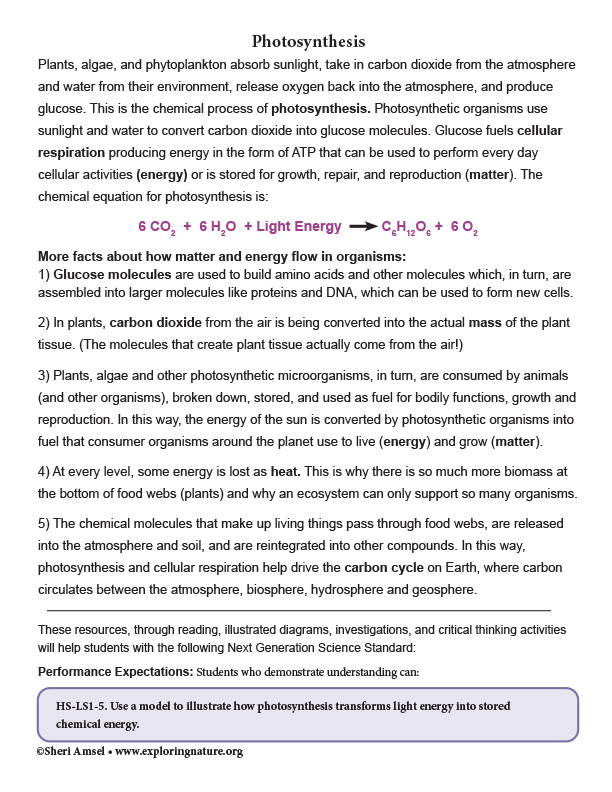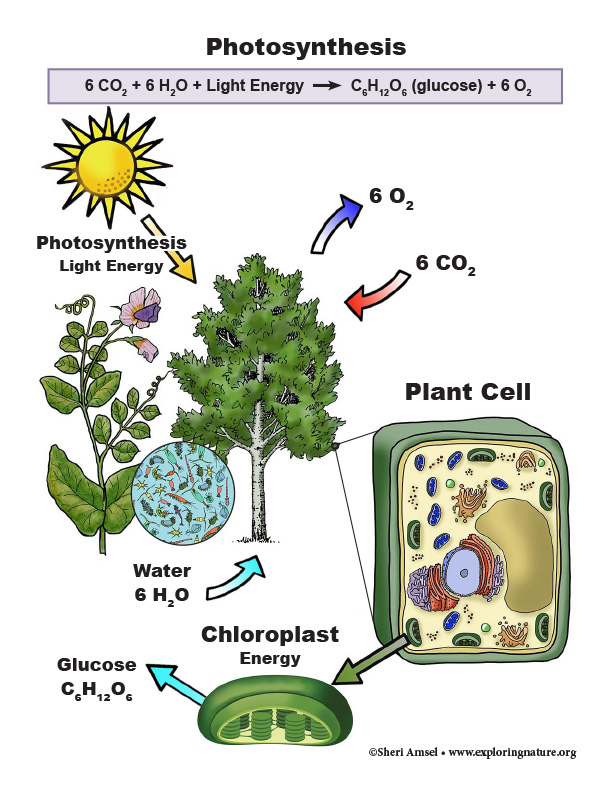

Plants, algae, and phytoplankton absorb sunlight, take in carbon dioxide from the atmosphere and water from their environment, release oxygen back into the atmosphere, and produce glucose. This is the chemical process of photosynthesis. Photosynthetic organisms use sunlight and water to convert carbon dioxide into glucose molecules. Glucose fuels cellular respiration producing energy in the form of ATP that can be used to perform every day cellular activities (energy) or is stored for growth, repair, and reproduction (matter). The chemical equation for photosynthesis is:
6 CO2 + 6 H2O + Light Energy ---> C6H12O6 + 6 O2
More facts about how matter and energy flow in organisms:
1) Glucose molecules are used to build amino acids and other molecules which, in turn, are assembled into larger molecules like proteins and DNA, which can be used to form new cells.
2) In plants, carbon dioxide from the air is being converted into the actual mass of the plant tissue. (The molecules that create plant tissue actually come from the air!)
3) Plants, algae and other photosynthetic microorganisms, in turn, are consumed by animals (and other organisms), broken down, stored, and used as fuel for bodily functions, growth and reproduction. In this way, the energy of the sun is converted by photosynthetic organisms into fuel that consumer organisms around the planet use to live (energy) and grow (matter).
4) At every level, some energy is lost as heat. This is why there is so much more biomass at the bottom of food webs (plants) and why an ecosystem can only support so many organisms.
5) The chemical molecules that make up living things pass through food webs, are released into the atmosphere and soil, and are reintegrated into other compounds. In this way, photosynthesis and cellular respiration help drive the carbon cycle on Earth, where carbon circulates between the atmosphere, biosphere, hydrosphere and geosphere.
Test your knowledge with a Photosynthesis - Short Answer Quiz.
Disciplinary Core Ideas
LS1.C: Organization for Matter and Energy Flow in Organisms
• The process of photosynthesis converts light energy to stored chemical energy by converting carbon dioxide plus water into sugars plus released oxygen. (HS-LS1-5)
Performance Expectations: Students who demonstrate understanding can:
HS-LS1-5. Use a model to illustrate how photosynthesis transforms light energy into stored chemical energy. [Clarification Statement: Emphasis is on illustrating inputs and outputs of matter and the transfer and transformation of energy in photosynthesis by plants and other photosynthesizing organisms. Examples of models could include diagrams, chemical equations, and conceptual models.] [Assessment Boundary: Assessment does not include specific biochemical steps.]
When you research information you must cite the reference. Citing for websites is different from citing from books, magazines and periodicals. The style of citing shown here is from the MLA Style Citations (Modern Language Association).
When citing a WEBSITE the general format is as follows.
Author Last Name, First Name(s). "Title: Subtitle of Part of Web Page, if appropriate." Title: Subtitle: Section of Page if appropriate. Sponsoring/Publishing Agency, If Given. Additional significant descriptive information. Date of Electronic Publication or other Date, such as Last Updated. Day Month Year of access < URL >.
Amsel, Sheri. "Photosynthesis (Grade 9-12)" Exploring Nature Educational Resource ©2005-2024. December 13, 2024
< http://www.exploringnature.org/db/view/Photosynthesis-Grade-9-12 >

